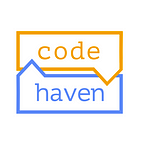Curriculum Update Fall 2020
Because Code Haven is looking quite a bit different this year, Aaron and I, as curriculum directors of Code Haven, wanted to give another update about how the curriculum has transitioned to online school!
The technical goal for the semester has remained the same: to allow students to create a maze project of their very own! However, as a board, we wanted to re-emphasize the overarching, ultimate goal of Code Haven, which is to instill in the students a love of coding and the belief that anyone can code. Especially given the difficulties that come with adjusting to online learning, Aaron and I focused our curriculum design this semester on prioritizing the ultimate goal of fun and learning at least something as opposed to spending too much time on meeting technical benchmarks.
Logistically, our weekly lesson plans still consist of five sections: the introduction/lecture component, the unplugged activity, live coding, worksheet, and wrap up.
Because we’ve learned that the transition from large-group time to break-out rooms or small-group can often be a hassle, we decided to split the class into two parts with only one transition in between. The lecture and the unplugged activity are in the large group, the worksheet and wrap up are in teams, and live coding is left up to the classroom leads discretion: we’ve learned that some students follow along better when live coding is done on a more one-on-one basis, allowing them to interrupt and ask questions.
Surprisingly, the lecture portion of the class has remained relatively the same as in-person lecture. The unplugged activities, which are fun non-coding activities that we use to teach coding-concepts, such as the gift-wrapping robot activity and the dance party, translated relatively well over to zoom. The powerpoint similarly is helpful in terms of creating a visual aid for students to focus on throughout the class.
The largest shift that we had this year was in our small groups. One key way in which we wanted to translate over the fun and collaborative nature that comes with in-person Code Haven was the creation of “teams.” While in the past, each individual classroom has attempted to prioritize keeping similar students with one mentor, this year we wanted to emphasize the idea that each group of students is in their own team with a mentor to lead them. The group of students are asked to work collaboratively, a priority we may even want to take into future years, even as we transition back into in-person classroom.the worksheet design. Additionally, by being in a smaller group, we facilitate both student-mentor interaction as well as peer-student interactions.
Our outreach team has also been hard at work creating an online sticker sheet in which students can feel as if they are getting a tangible sticker as a reward for checkpoints in the worksheet!
While being online has afforded some benefits — for example, we can add fun gifs to an online worksheet! — we also encountered several unexpected challenges: students often find it difficult to type in the worksheet while simultaneously having a Scratch window open. In order to remedy this issue, we standardized the mentor screen-sharing the worksheet and typing in the boxes students’ answers curated through group discussion.
Finally, in order to keep track of our student’s progress and to get them reflecting on what they have learned, we uniformly ask three wrap-up questions at the end of every lesson:
- What did you learn today?
- What are you still confused about?
- Did you find this lesson fun and engaging?
Overall, we’ve found the transition to online a bit tricky at times, but overall a learning process that we are getting better at every day!
Originally published at https://www.codehavenyale.com.
